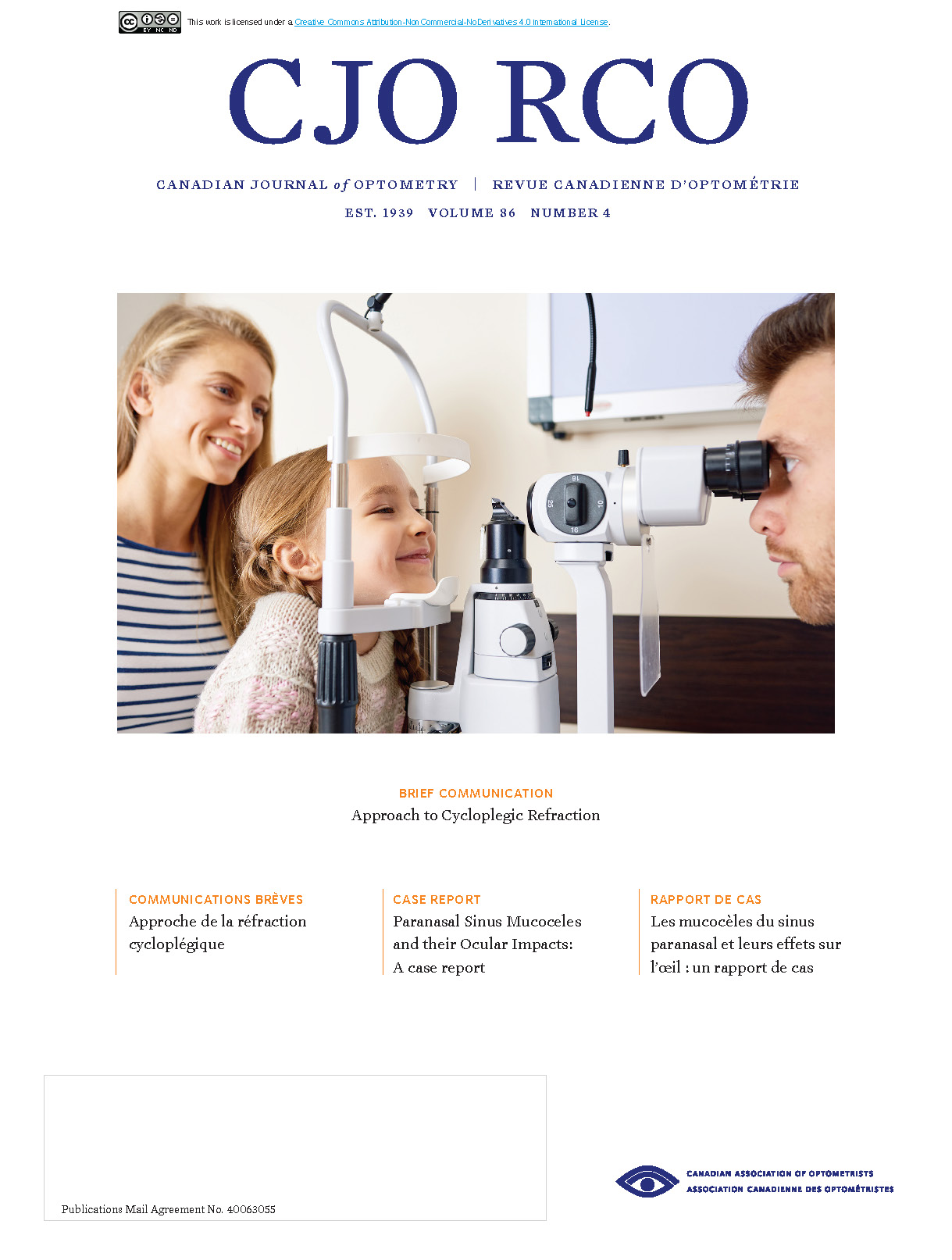Approach to cycloplegic refraction
DOI:
https://doi.org/10.15353/cjo.v86i4.5951Keywords:
cycloplegic refraction, accommodation, esotropia, cyclopentolate, pseudomyopiaAbstract
Children and younger adults are able to overcome some of the challenges posed by uncorrected refractive errors due to their potent accommodative abilities. However, this potent accommodative ability can significantly affect the precision of their refractive error’s assessment. To overcome this, paediatric cycloplegic refraction becomes indispensable as the prevalence of uncorrected refractive errors among children is on the increase globally. Cycloplegic refraction is the process by which refractive errors are assessed, measured and quantified using a cycloplegic agents such as homatropine and cyclopentolate. Long standing uncorrected refractive errors in children may predispose them to strabismus (squint), amblyopia (lazy eyes), non-optimal vision, asthenopic symptoms like eyestrain, tearing, and could even accelerate myopia progression. This brief review of paediatric cycloplegic refraction is aimed at pointing out some critical steps, methods, and cycloplegic agents essential in carrying out the procedure to meet the growing need for precise refraction outcome and addressing the rising prevalence of paediatric refractive errors, related cases. It also showcases some guidelines for paediatric cycloplegic spectacle prescription dispensing. It involved long years of dedicated clinical input and review of related literatures relevant to the procedure. Cycloplegic refraction is also indicated in the determination of the full hyperopic correction in the management of manifest childhood esotropia, accommodative spasm, amblyopia, anisometropia, uncompensated esophoria; and suspected pseudomyopia. This will guarantee accurate vision treatment, visual health protection, improvement in children’s academic performance, and overall quality of life of the young generation. Through it, a need for advocacy for an evidence-based paediatric eye care practice; interdisciplinary collaboration among eye care professionals, and supporting research and development of new cycloplegic agents and protocols may be created.
Keywords: cycloplrgic refraction, accommodation, esotropia, cyclopentolate, pseudomyopia.
References
1. International Labour Organisation. ‘Eye health and the world of work’, Geneva: International Labour Office. http://www.ilo.org/publns. Published September 5, 2023. Accessed October 7, 2007
2. Sano BS, Diyale SP. Barriers to spectacle acceptance among secondary school students in Igabi, North-Western Nigeria. Internat J Comm Med Public Health. 2020; 7(11):4283-4288.
3. Ho M, Morjaria P. Cycloplegic refraction in children. Comm Eye Health J. 2024;37(122): 14-15.
4 Kearns LS, Hewitt AW, Ruddle JB, Bigault O, Staffieri SE, Sanffillipo P, Martin NG, Hammonnd CJ, Young TL, Mackey DA. Up to What Age is Cycloplegic Refraction Required? Results From the Twin Eye Study Tasmania (TEST). Invest Ophthalmol Vis Sci. 2010;51(13):1716.
5. Saxena R, Sharma P; Pediatric Ophthalmology Expert Group. National consensus statement regarding pediatric eye examination, refraction, and amblyopia management. Indian J Ophthalmol. 2020 Feb;68(2):325-332. doi: 10.4103/ijo.IJO_471_19.
6. Major E, Dutson T, Moshirfar M. Cycloplegia in Children: An Optometrist’s Perspective. Clin Optom (Auckl). 2020 Aug 25;12:129-133. doi: 10.2147/OPTO.S217645.
7. Nelson ME, Orton DBO. Counteracting the effects of mydriatics. Arch Ophthalmol. 1983; 105:486.
8. Zurevinsky J, Sawchuk K, Lim HJ, Lee CH, Rubab S. A Clinical Randomized Trial Comparing the Cycloplegic Effect of Cyclopentolate Drops Applied to Closed Eyelids Versus Open Eyelids. Am Orthopt J. 2016 Jan;66(1):114-121. doi: 10.3368/aoj.66.1.114.
9. Vagge A, Del Noce C, Pellegrini M, Cappelli F, Musolino M, Bernabei F, Giannaccare G, Traverso CE. Efficacy of a Cycloplegic Agent Administered as a Spray in the Pediatric Population. J Pediatr Ophthalmol Strabismus. 2020 Sep 1;57(5):301-304. doi: 10.3928/01913913-20200803-01
10. Khurana AK, Khurana KA, Khurana B. Comprehensive Ophthalmology. 6th.ed. New Delhi: Jaypee Brothers; 2015:570-580.
11. Sani RY, Hassan S, Habib SG, Ifeanyichukwu EP. Cycloplegic effect of atropine compared with cyclopentolate-tropicamide combination in children with hypermetropia. Niger Med J. 2016 May-Jun;57(3):173-7. doi: 10.4103/0300-1652.184065.
12. AI-Thawabieh W, AI-Omari R, Abu-Hassan DW, Abuawwad MT, AI-Awadhi A, Abu Serhan H. Tropicamide versus cyclopentolate for cycloplegic refraction in pediatric patients with brown irides: a randomized clinical trial. Am J Ophthalmol 2024; 257:218-226.
13. Allan JF, Frederick WF. Ophthalmic Therapeutics. In: Asbury T, Riordan-Eva P, Vaughan T. Emmett TC Jr. eds. General Ophthalmology. 18th ed. New York: McGraw-Hill; 2011: 412-430.
14. Wutthiphan S. Guidelines for prescribing optical correction in children. J Med Assoc Thai. 2005 Nov;88 Suppl 9:S163-9. PMID: 16681071.
Downloads
Published
How to Cite
Issue
Section
License
Copyright (c) 2024 Collins Onyeahiri

This work is licensed under a Creative Commons Attribution-NonCommercial-NoDerivatives 4.0 International License.


